Egg binding
3 posters
:: Freshwater :: Freshwater General
Page 1 of 1
 Egg binding
Egg binding
The question of egg binding came up on another thread. It can be a real problem with a lot of fish when they are kept as we tend to keep them.
There are several reproductive strategies for egg-laying fish. One is to lay a few eggs every day, using the energy from food to determine how many. Another, favoured by Cichlids, is to lay a few, and guard them. Egg binding is a problem for egg-scatterers, the fish that seasonally produce huge numbers of eggs on the principle that a few fry will make it. These fish practice no brood care, but go all out for quantity. Some will lay thousands of eggs in one run.
Egg scatterer, meet overfeeding aquarist. The female egg scatterer (let's call her "the fish") is always hungry, but never more so than when she's loading up. Fish always want to eat because they are adapted to the wild, where food can be in short supply, or where if food is plentiful, you still have to work hard to get it. Super rich and nutritious flakes falling from the sky are fast food looking for a pair of hips.
The biological goal of your fish is to make more fish. With rich food, the seasonal breeding mechanism can go into overdrive. The surplus food is used to make eggs, lots of eggs. Some fish will just drop them unfertilized, in time. Some others turn into the big bellied, uncomfortable neons, danios and cardinals we've all seen.
Most of the time, the eggs need a trigger. Spawning is timed to many factors. I have heard of aquarists flashing lights and doing slightly cooler water changes to simulate thunderstorms starting the rainy season. Others will add peat stained, tannin rich water to the tank, to simulate the flooding of the Amazon forest (a time of plenty for fish, so the start of spawning season). Zebras unload with a rush of cool water and aeration. Even if you don't want babies, or as is more likely, the eggs can't be fertile in your water, it helps to help your fish get them out.
Epsom salts are a muscle relaxant, and some aquarists use a bath to get a suffering female to release.
Sometimes nothing works, and the fish has a rough life. Too much food is a terrible thing. It kills fish like it kills us. Fish are lean creatures, and when they do get fat, it gathers around their organs and seriously shortens their lives. You have to learn to watch for signs of fish you can't breed, or don't intend to breed being accidentally 'conditioned' for breeding by misdirected kindness, and go easy on the feeding. Less is usually good.
And that is easier said than done.
There are several reproductive strategies for egg-laying fish. One is to lay a few eggs every day, using the energy from food to determine how many. Another, favoured by Cichlids, is to lay a few, and guard them. Egg binding is a problem for egg-scatterers, the fish that seasonally produce huge numbers of eggs on the principle that a few fry will make it. These fish practice no brood care, but go all out for quantity. Some will lay thousands of eggs in one run.
Egg scatterer, meet overfeeding aquarist. The female egg scatterer (let's call her "the fish") is always hungry, but never more so than when she's loading up. Fish always want to eat because they are adapted to the wild, where food can be in short supply, or where if food is plentiful, you still have to work hard to get it. Super rich and nutritious flakes falling from the sky are fast food looking for a pair of hips.
The biological goal of your fish is to make more fish. With rich food, the seasonal breeding mechanism can go into overdrive. The surplus food is used to make eggs, lots of eggs. Some fish will just drop them unfertilized, in time. Some others turn into the big bellied, uncomfortable neons, danios and cardinals we've all seen.
Most of the time, the eggs need a trigger. Spawning is timed to many factors. I have heard of aquarists flashing lights and doing slightly cooler water changes to simulate thunderstorms starting the rainy season. Others will add peat stained, tannin rich water to the tank, to simulate the flooding of the Amazon forest (a time of plenty for fish, so the start of spawning season). Zebras unload with a rush of cool water and aeration. Even if you don't want babies, or as is more likely, the eggs can't be fertile in your water, it helps to help your fish get them out.
Epsom salts are a muscle relaxant, and some aquarists use a bath to get a suffering female to release.
Sometimes nothing works, and the fish has a rough life. Too much food is a terrible thing. It kills fish like it kills us. Fish are lean creatures, and when they do get fat, it gathers around their organs and seriously shortens their lives. You have to learn to watch for signs of fish you can't breed, or don't intend to breed being accidentally 'conditioned' for breeding by misdirected kindness, and go easy on the feeding. Less is usually good.
And that is easier said than done.

GaryE- Veteran Member

- Posts : 2505
Join date : 2013-09-07
 Re: Egg binding
Re: Egg binding
Thank you for posting this information Gary. I didn't fully realize how at-risk my cardinals were for egg binding.
I'm still not sure how to tell if a female is egg bound or just naturally larger/plumper due to sexual dimorphism, other than studying photos of healthy male and female fish and comparing them to my stock...? Is there a difference between a "conditioned" female and an egg bound one? Do females behave differently when they are egg bound? Can you tell that they are uncomfortable?
Bad photo quality but here is a photo of one of my female cardinals next to one of my males. Would you call this "reasonably plump" or "uncomfortably egg bound"? Thanks.

I'm still not sure how to tell if a female is egg bound or just naturally larger/plumper due to sexual dimorphism, other than studying photos of healthy male and female fish and comparing them to my stock...? Is there a difference between a "conditioned" female and an egg bound one? Do females behave differently when they are egg bound? Can you tell that they are uncomfortable?
Bad photo quality but here is a photo of one of my female cardinals next to one of my males. Would you call this "reasonably plump" or "uncomfortably egg bound"? Thanks.


cephalotus- Angel Fish

- Posts : 401
Join date : 2013-09-08
Location : Saskatoon, SK
 Re: Egg binding
Re: Egg binding
She has some eggs there, but could still expel them with time. If she gets a lot bigger, it's not difficult to imagine her having a hard time. That's not binding, but it is a conditioned female. If I were breeding cardinals (I tried and managed to see one fry, which promptly died) I would pick her as she is a healthy, egg laden female. But I don't think she's crossed the line to it being any kind of problem.
They are nice cardinals.
They are nice cardinals.

GaryE- Veteran Member

- Posts : 2505
Join date : 2013-09-07
 Re: Egg binding
Re: Egg binding
Thank you Gary! I have two more that look just like her. I honestly did not realize that egg binding was that much of a Thing for egg-scatterers.  I thought I was being so good to them by feeding them such high quality food. Just goes to show that there is always more to learn!
I thought I was being so good to them by feeding them such high quality food. Just goes to show that there is always more to learn!
So, like, will she just keep accumulating eggs until it becomes a problem? If she is well conditioned but not over conditioned will she retain some eggs inside her but stop producing more/absorb the excess? Is it possible that she has been continually producing and dropping (unfertilized?) eggs all this time and I haven't noticed?
This stuff is all fascinating and not the kind of thing you find information about in aquarium/fish care 101. Glad you and the other experienced fish keepers are here to answer questions and give advice!
So, like, will she just keep accumulating eggs until it becomes a problem? If she is well conditioned but not over conditioned will she retain some eggs inside her but stop producing more/absorb the excess? Is it possible that she has been continually producing and dropping (unfertilized?) eggs all this time and I haven't noticed?
This stuff is all fascinating and not the kind of thing you find information about in aquarium/fish care 101. Glad you and the other experienced fish keepers are here to answer questions and give advice!

cephalotus- Angel Fish

- Posts : 401
Join date : 2013-09-08
Location : Saskatoon, SK
 Re: Egg binding
Re: Egg binding
she is probably dropping eggs and even a male fertilizing them, but eating them within the hour. Cardinals seem like such good egg eaters its amazing. Not one egg of any species can be seen when they are around....

caoder- Pleco Poster

- Posts : 689
Join date : 2013-09-07
Location : Montreal
 Re: Egg binding
Re: Egg binding
One weird trick is to stop feeding for a few days. It's amazing what the instinctual realization of mortality will do to fish sexuality. There does seem to be an "OMG, I'd better get some eggs out" moment for some of them. It can actually make them shed eggs.
Binding happens when they can't. With cardinals, I agree with Caoder that they are probably spawning, but for the eggs to be fertile, the conditions have to be 'perfect' within a narrow range of almost no hardness, low pH and darkness. So there's no real chance of babies showing up, but that won't stop them trying.
It's weird though - glowlights will spawn in most medium hardness tapwater, but there are few fish as prone to serious egg-binding as they are, from what I have seen in my tanks.
Binding happens when they can't. With cardinals, I agree with Caoder that they are probably spawning, but for the eggs to be fertile, the conditions have to be 'perfect' within a narrow range of almost no hardness, low pH and darkness. So there's no real chance of babies showing up, but that won't stop them trying.
It's weird though - glowlights will spawn in most medium hardness tapwater, but there are few fish as prone to serious egg-binding as they are, from what I have seen in my tanks.

GaryE- Veteran Member

- Posts : 2505
Join date : 2013-09-07
:: Freshwater :: Freshwater General
Page 1 of 1
Permissions in this forum:
You cannot reply to topics in this forum
 Alexmtl
Alexmtl


» Anyone still around? Need help transporting fish
» Stocking suggestions
» New Tank Purchase
» 3 Gallon Tetra half moon tank
» White floaty stuff in gold fish tank
» Ammonia in tap water
» Need advice for beginner with fresh water tank
» Fluval FX5 hose size?
» smart fish, dumb fish, pink fish...um, what rhymes with dumb?
» Is K&E sandblasting sand same as Black diamond?
» What the...is that a leak? NOOOOOOOOOOO!!!!! (a comedy of horrors...)
» Air stones and the noise they make
» aquatic medications
» film like stuff on the water surface of shark tank
» Articles on swordtail behaviour and fathead minnows
» Lets see your predators!
» Humane way to PTS a shark
» My tanks (Introducing myself)
» Build your own aquarium